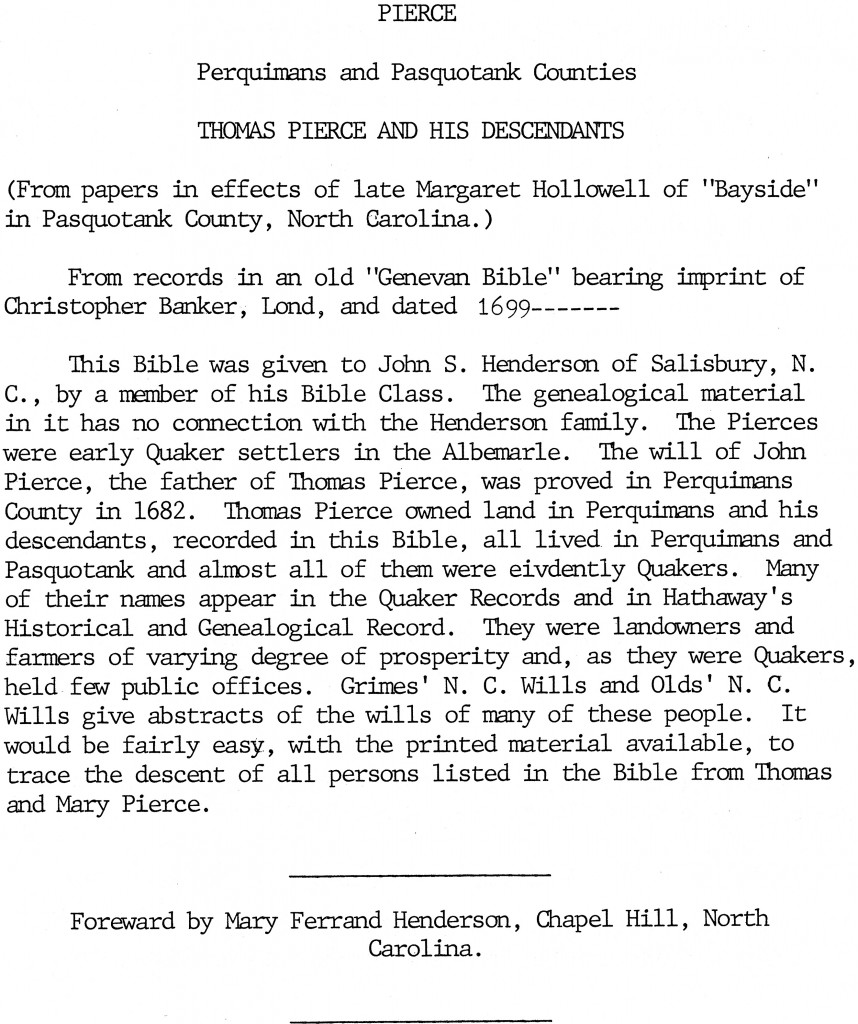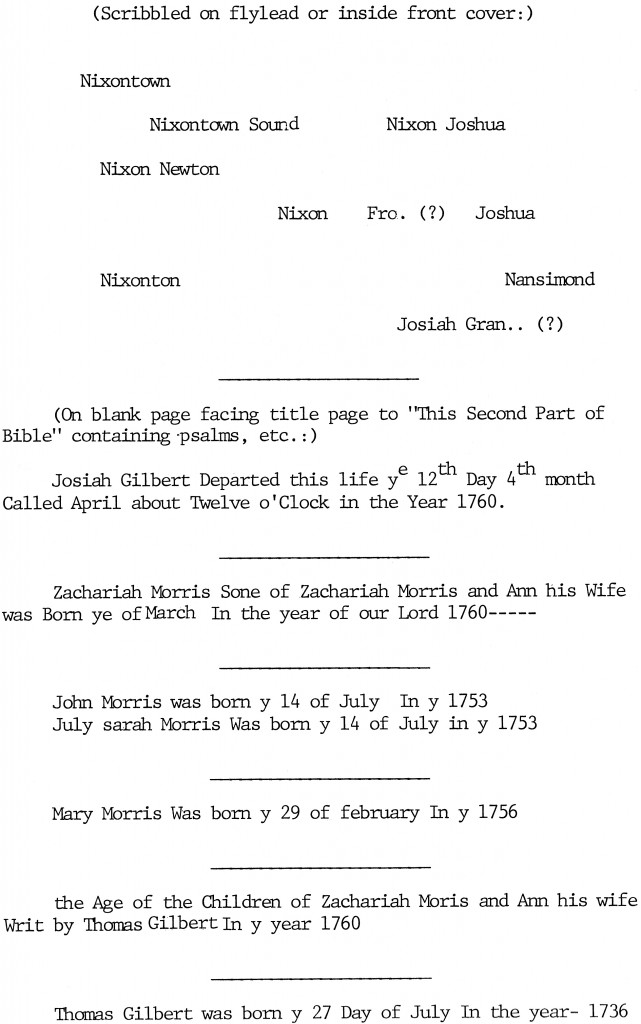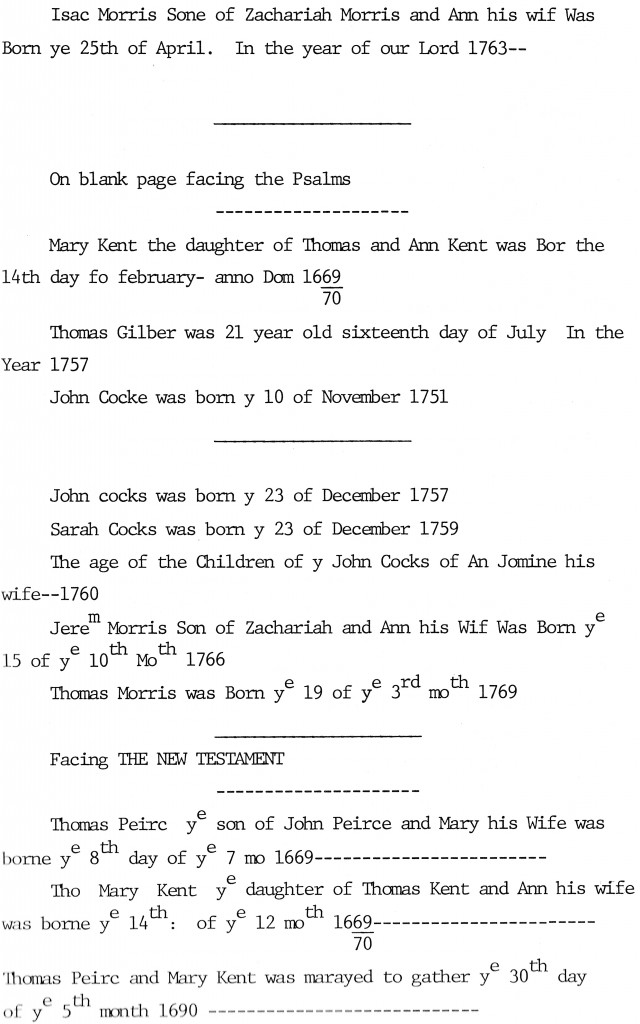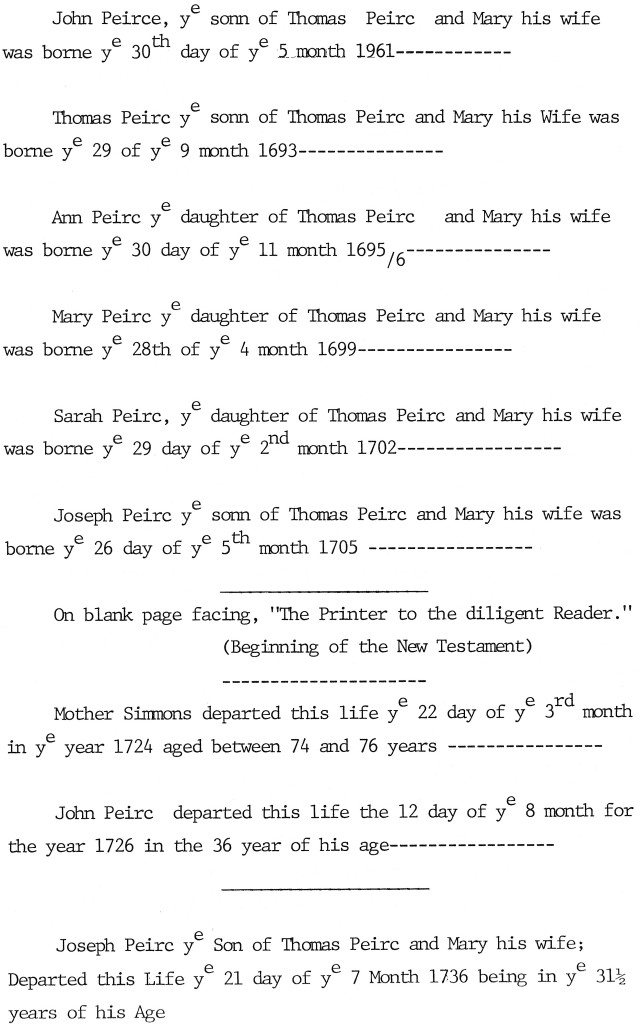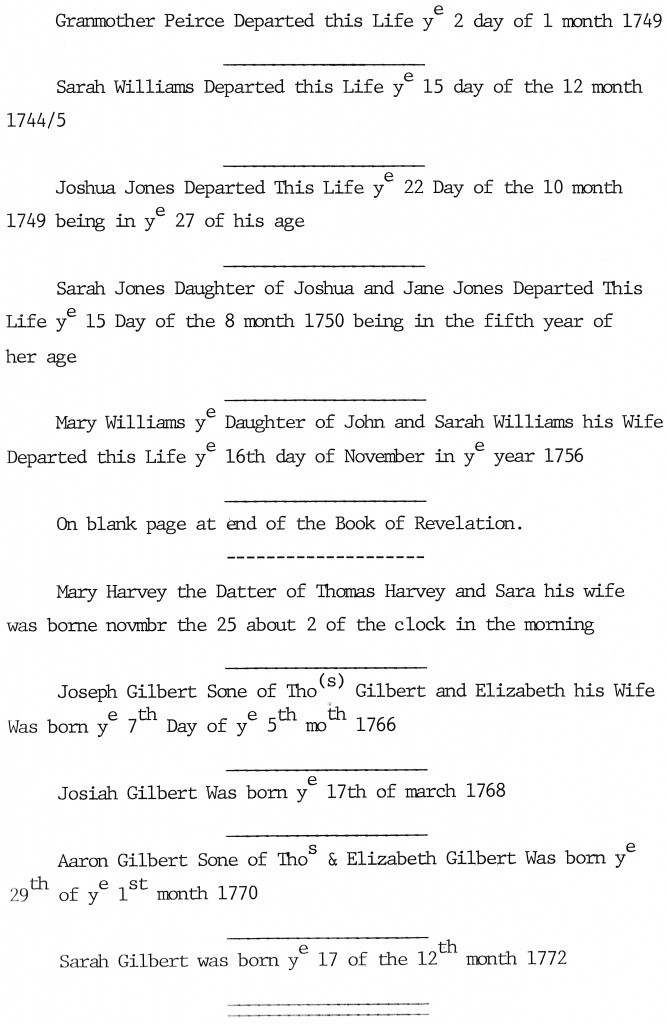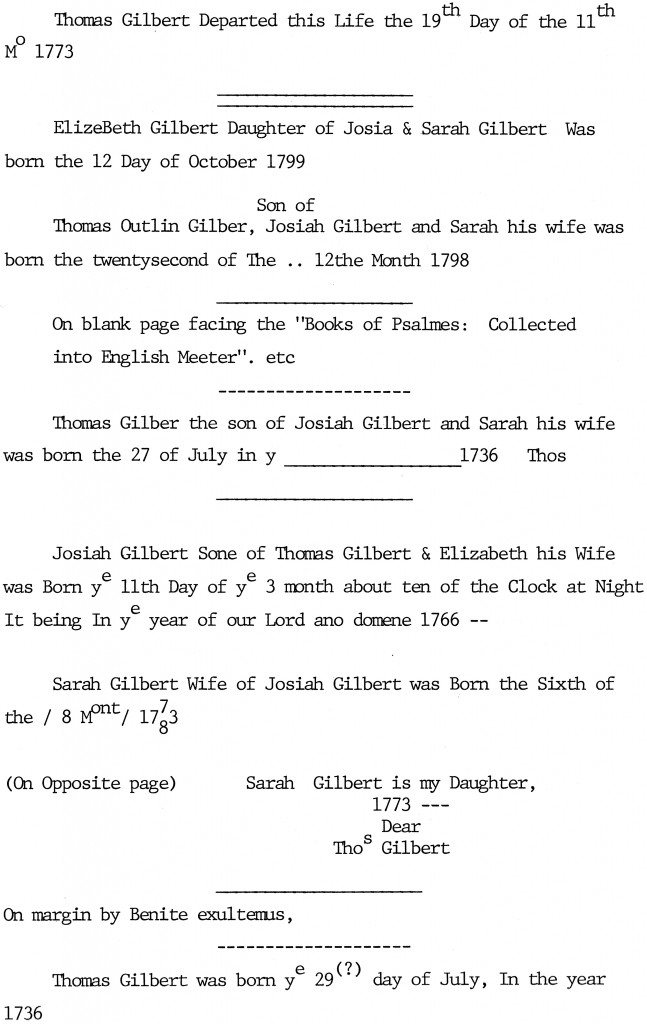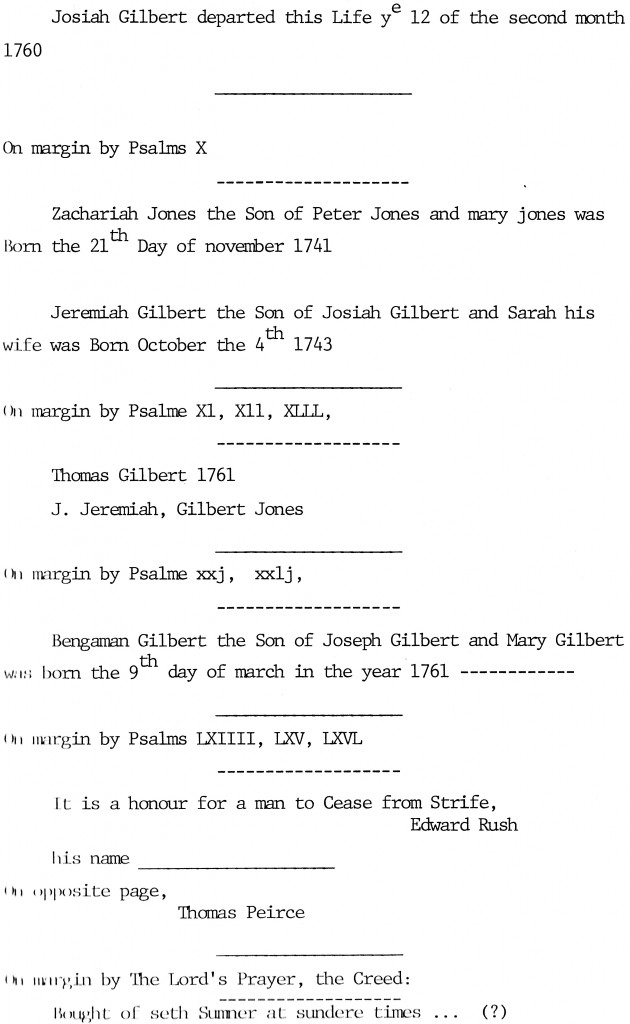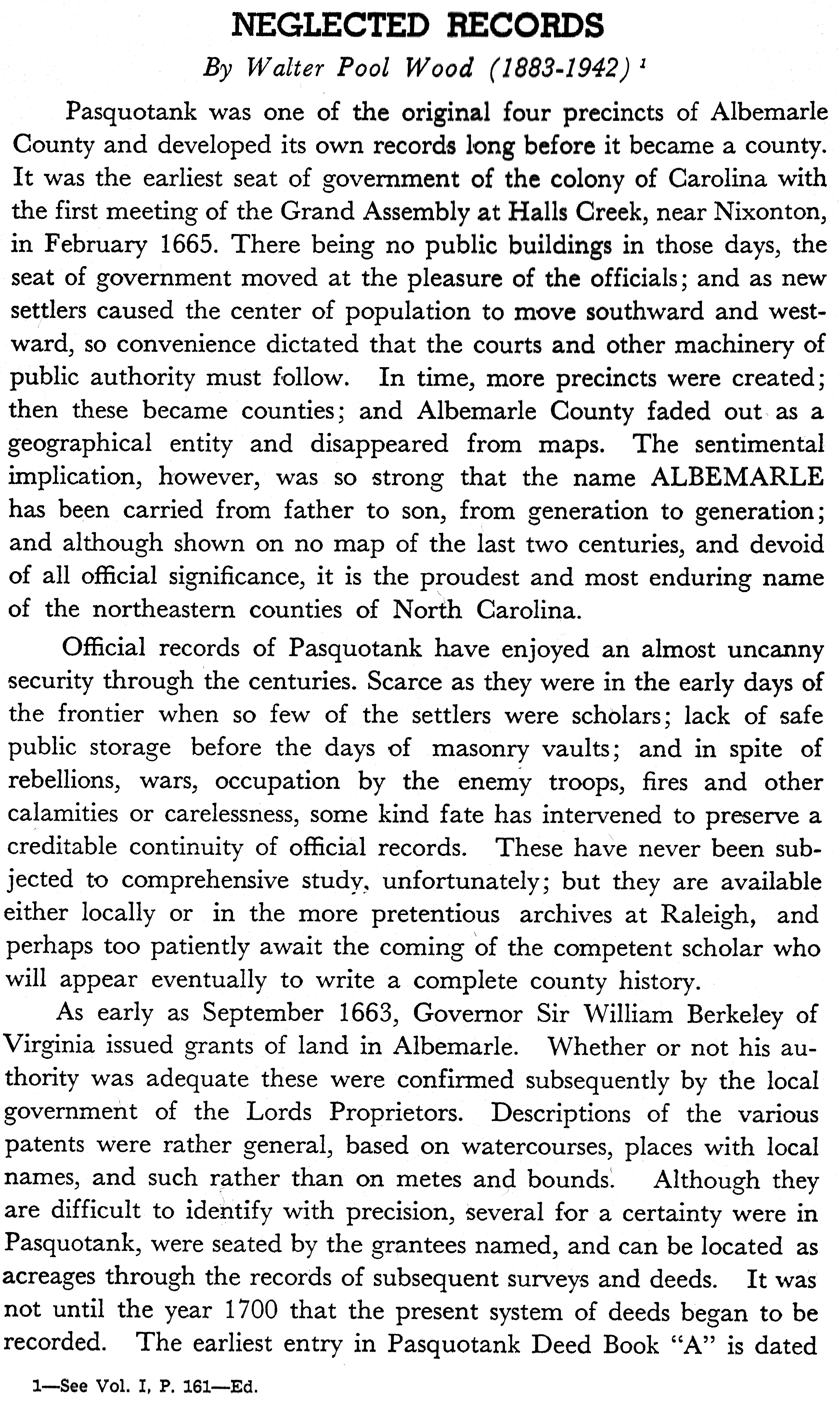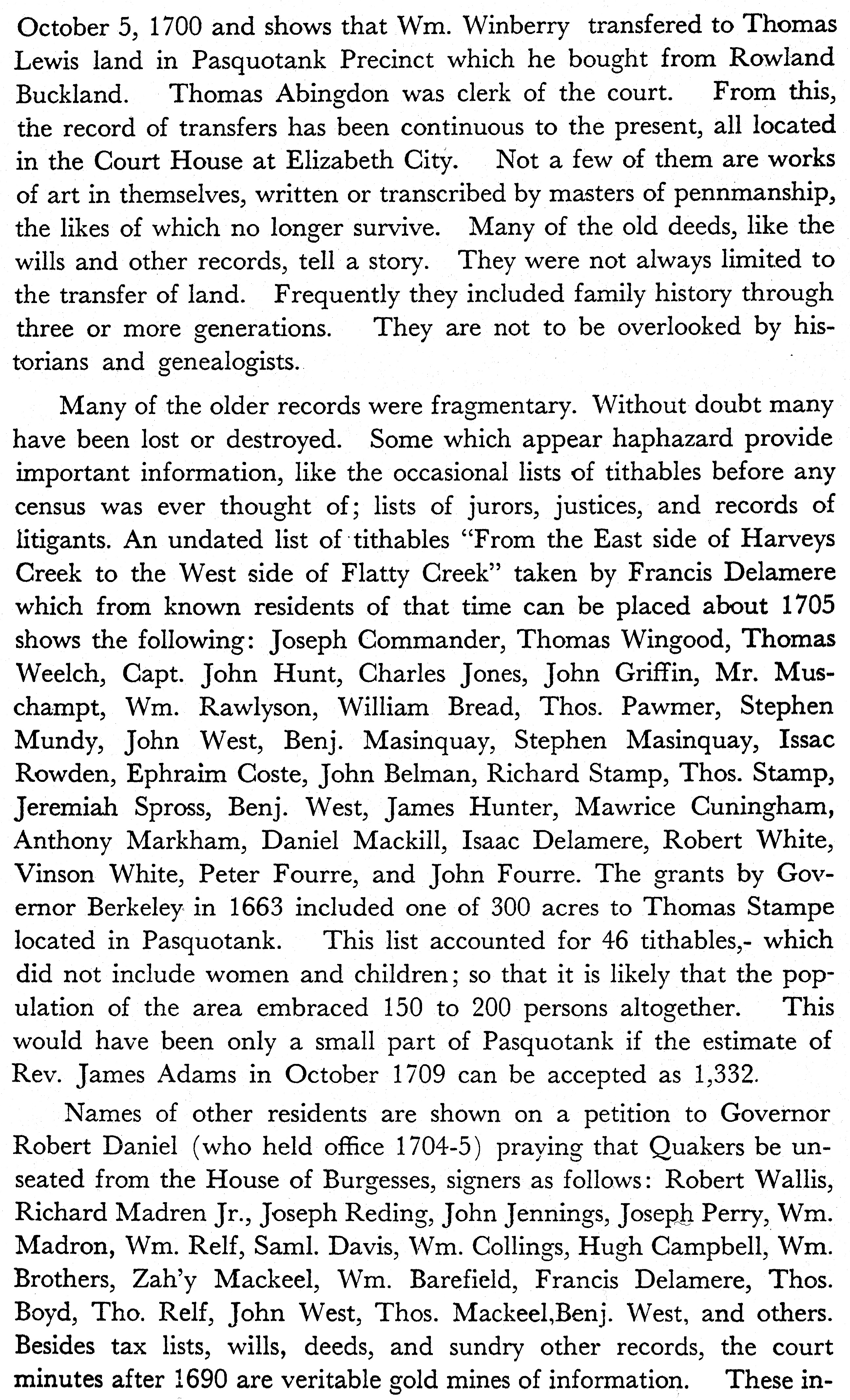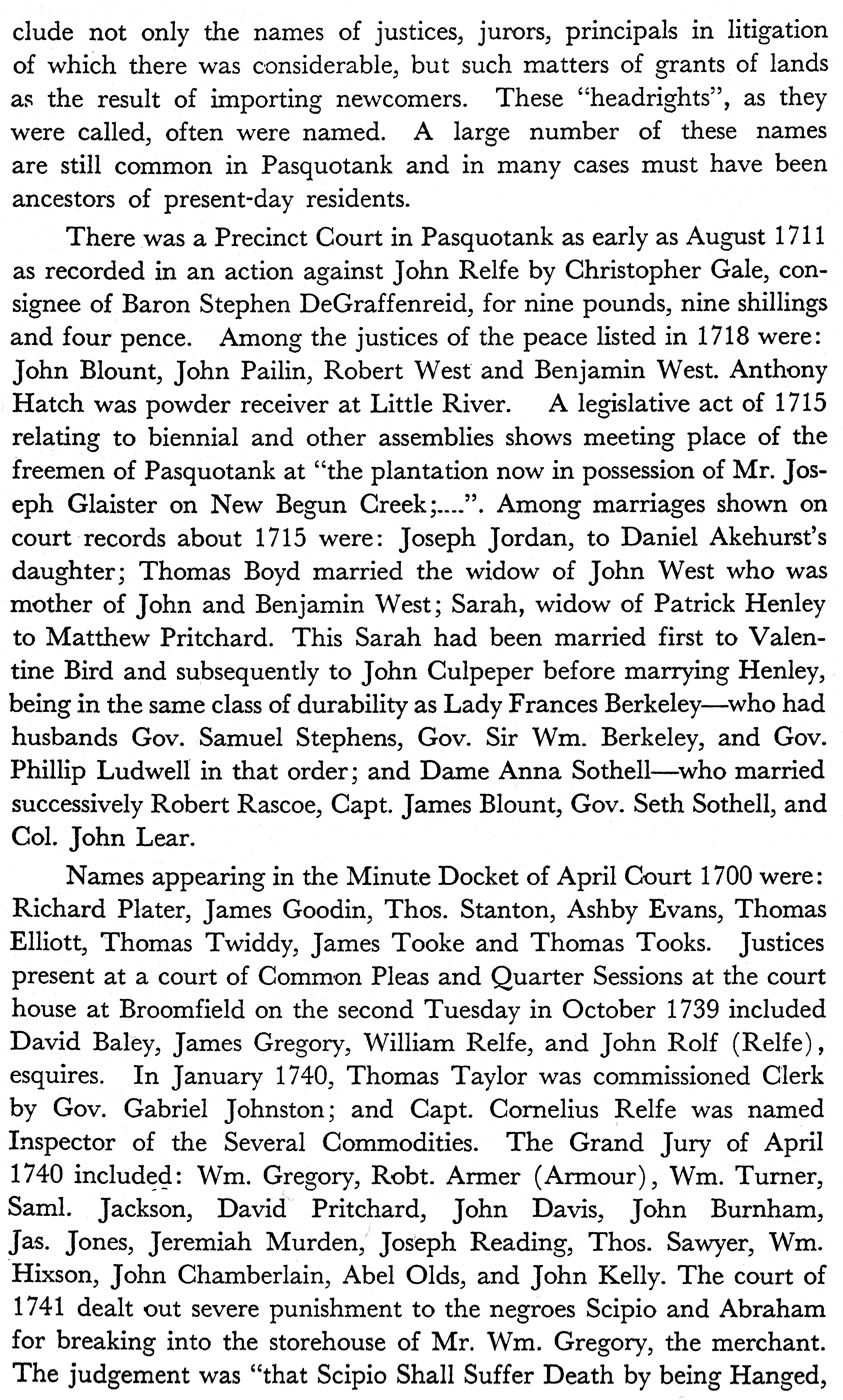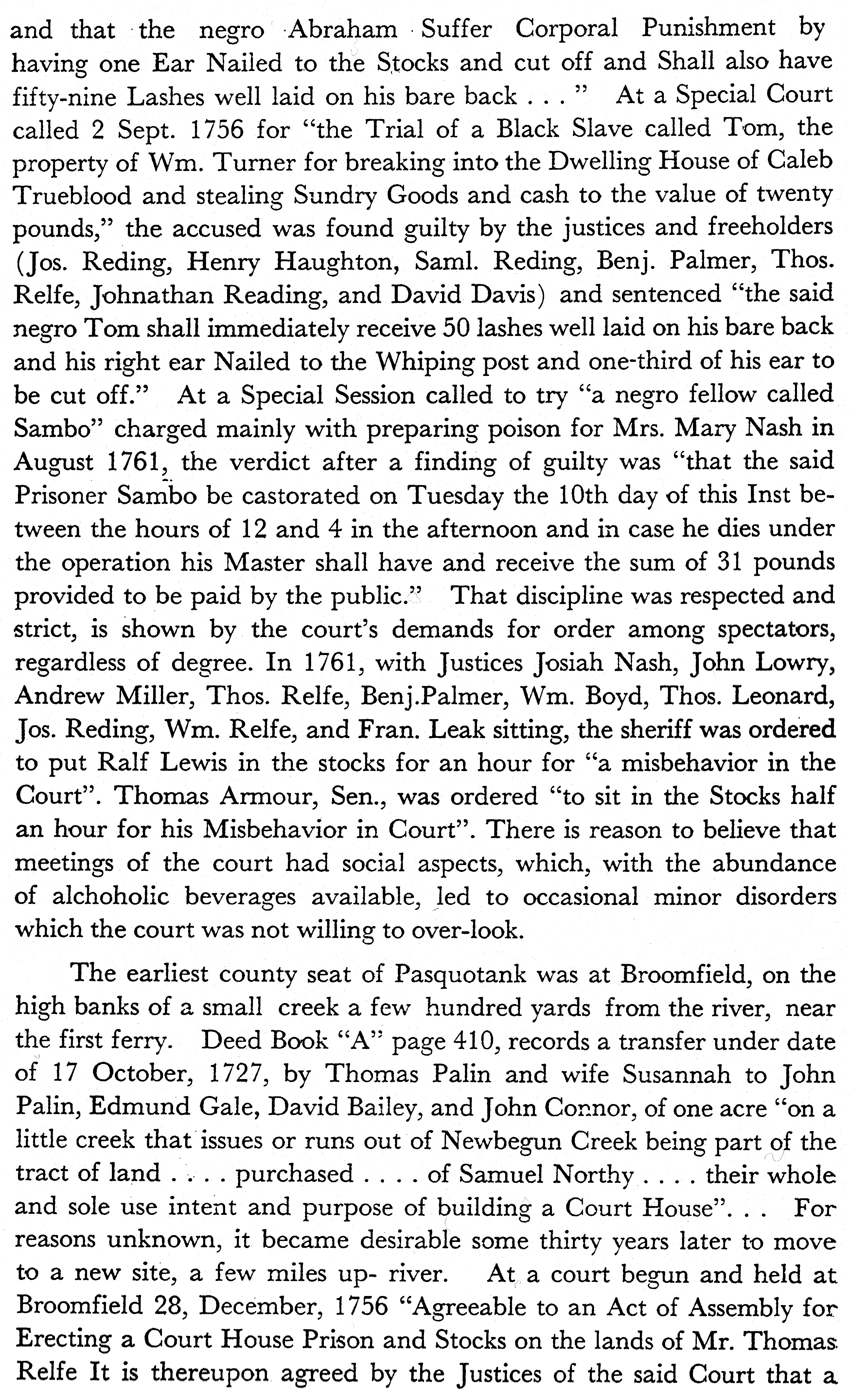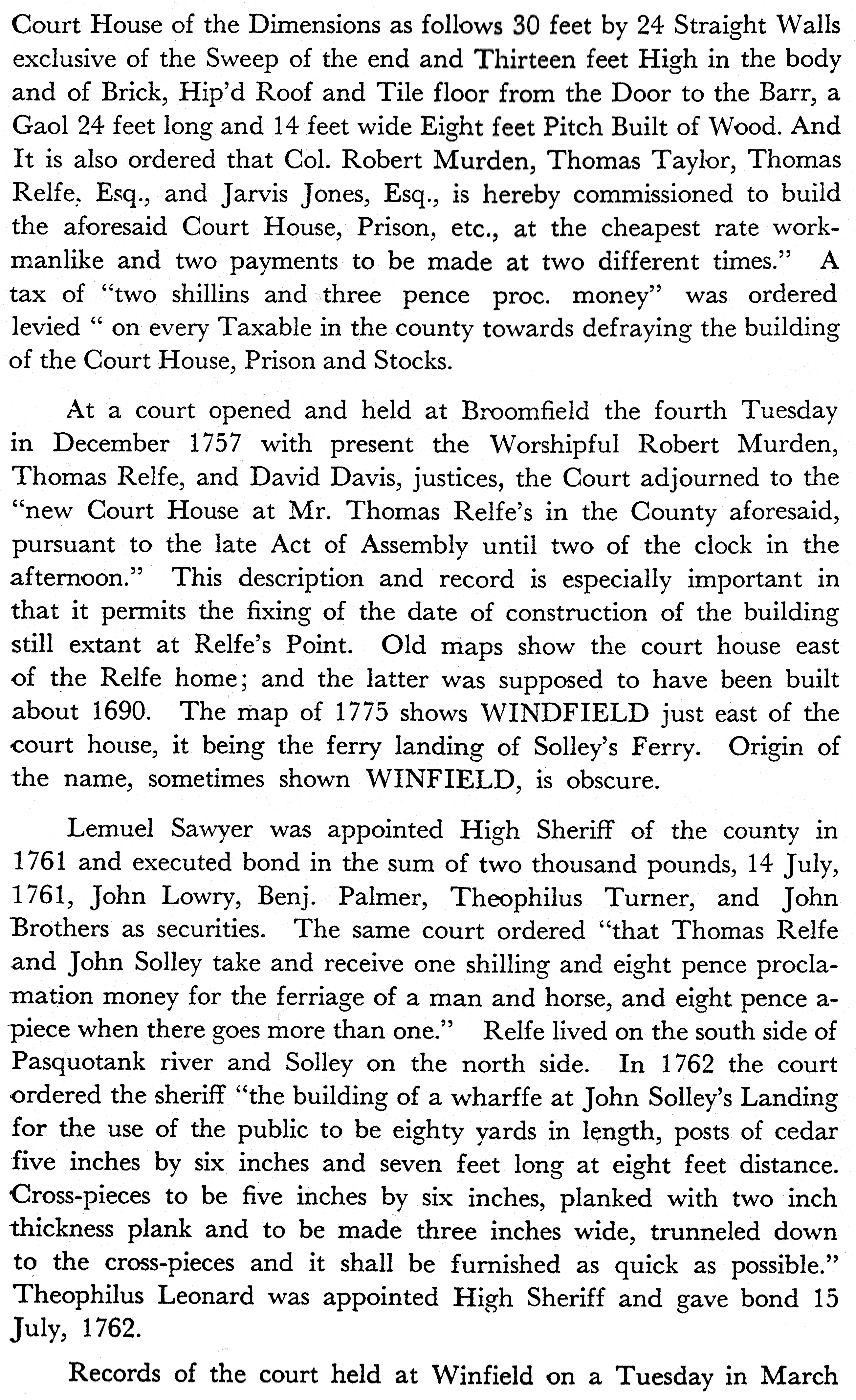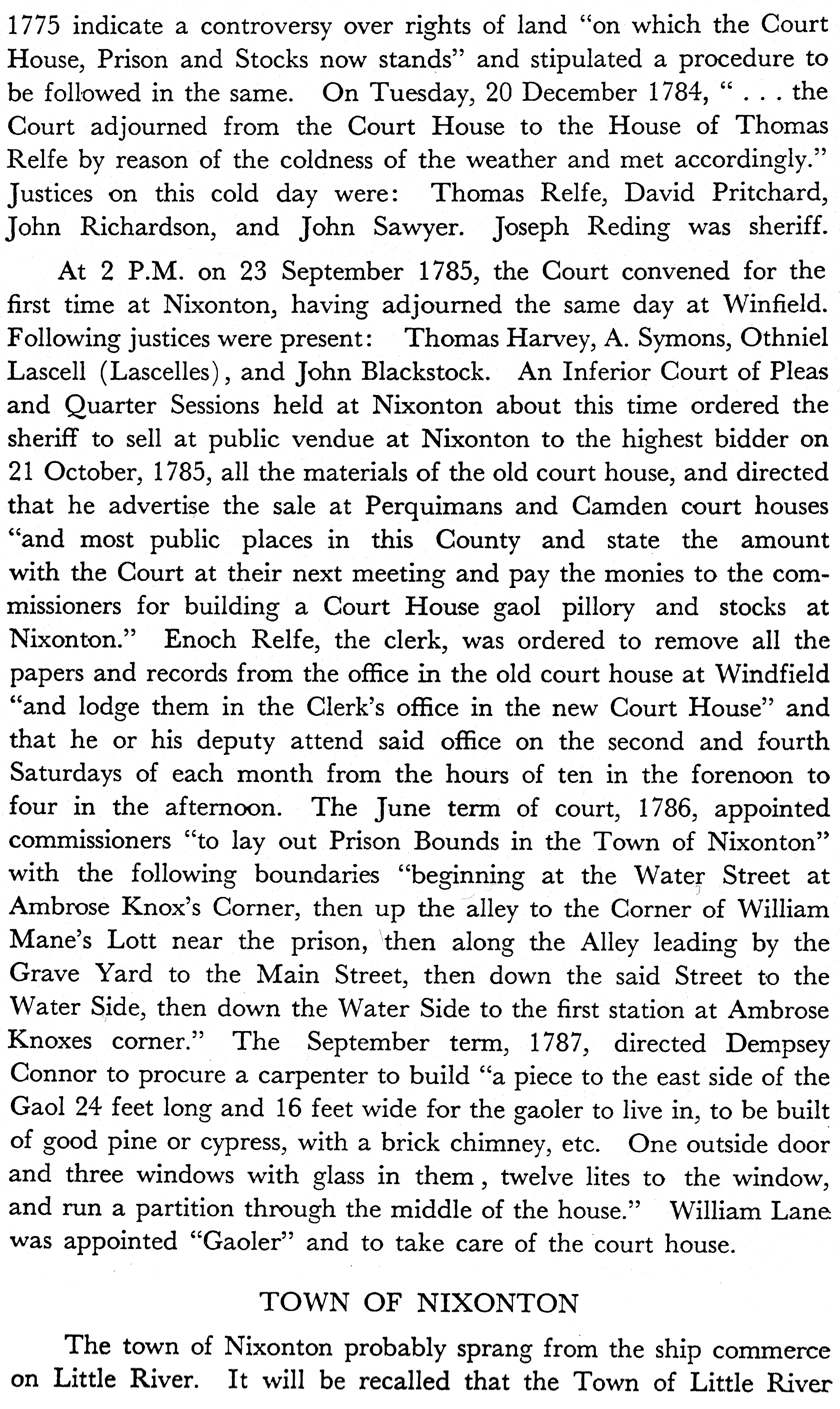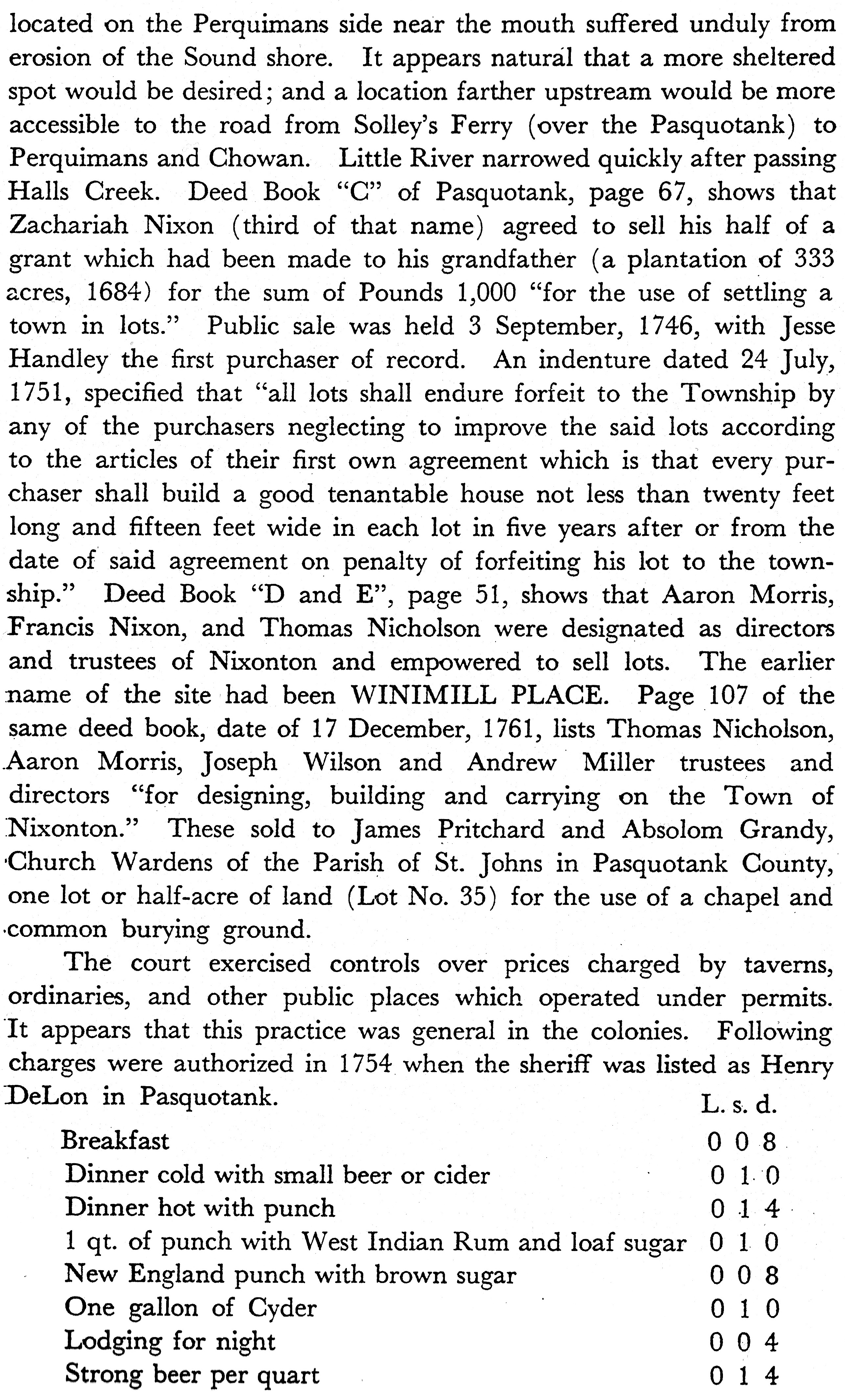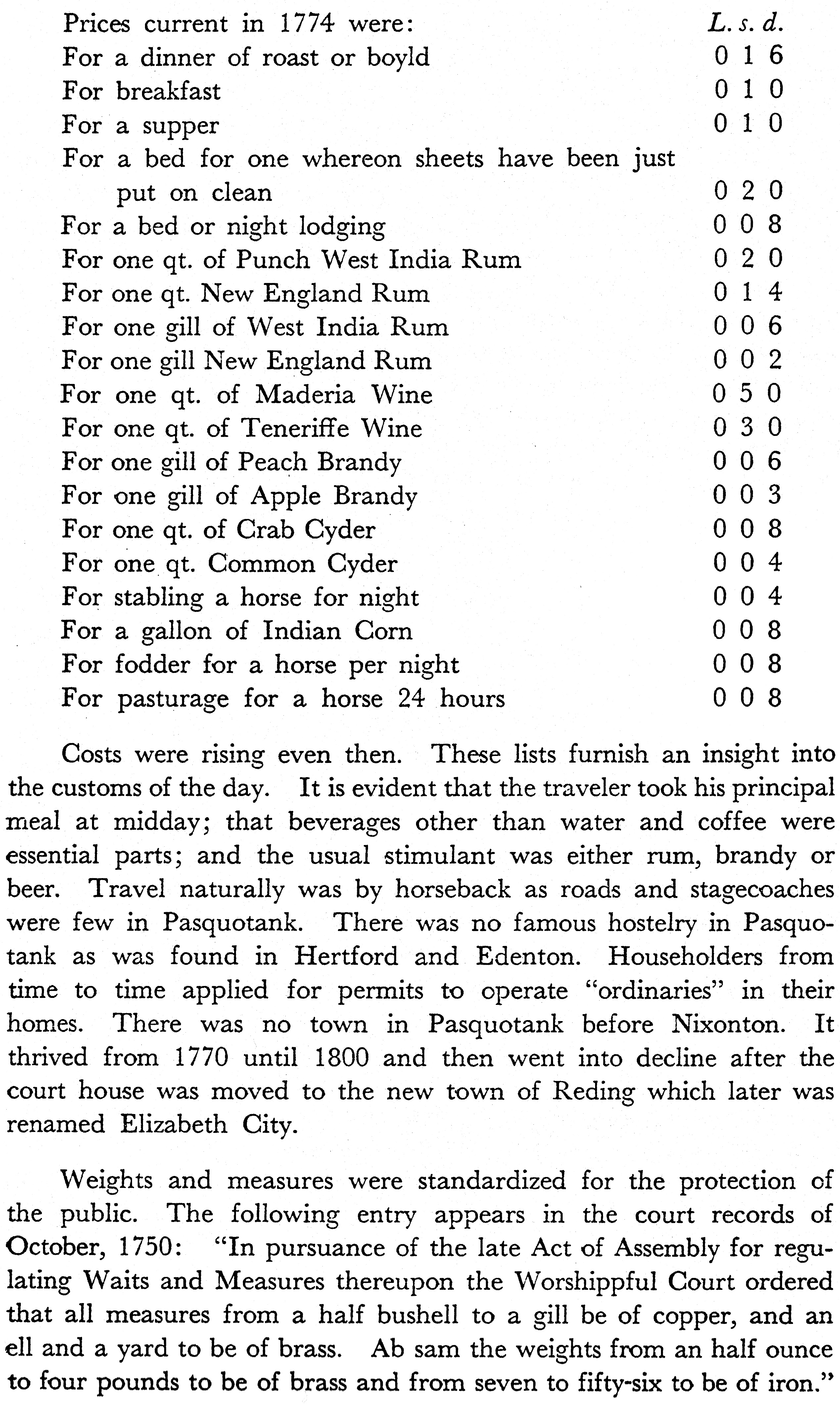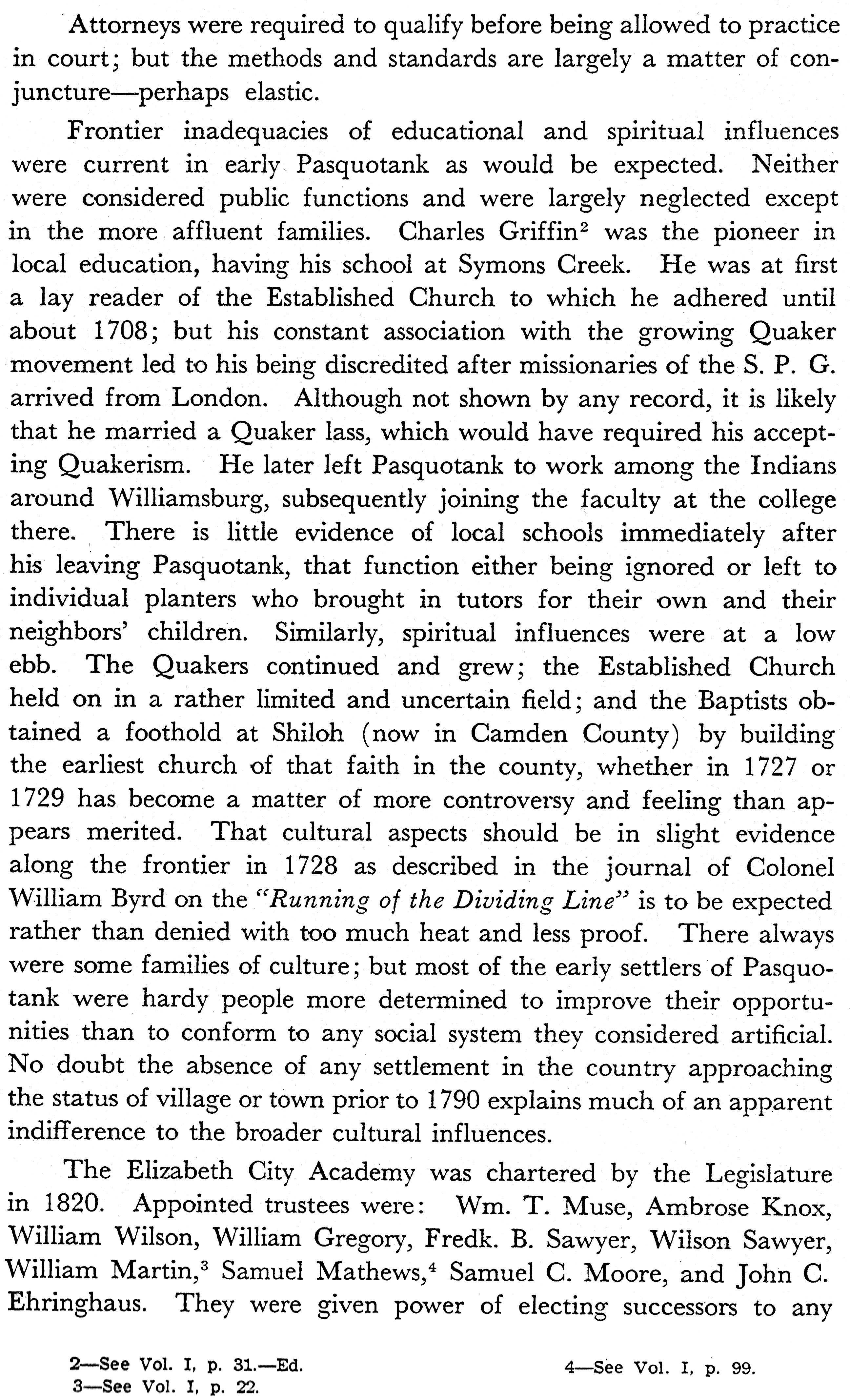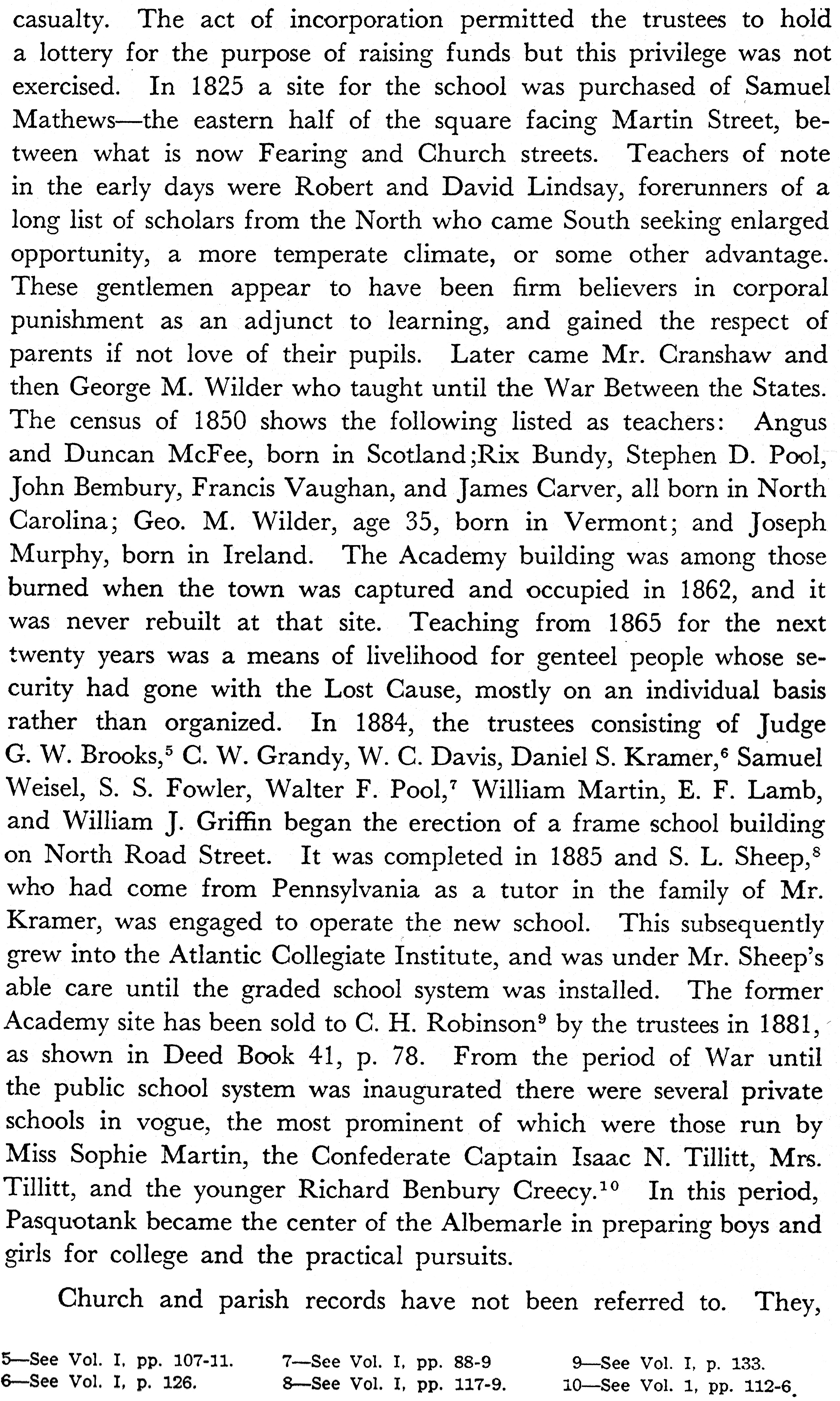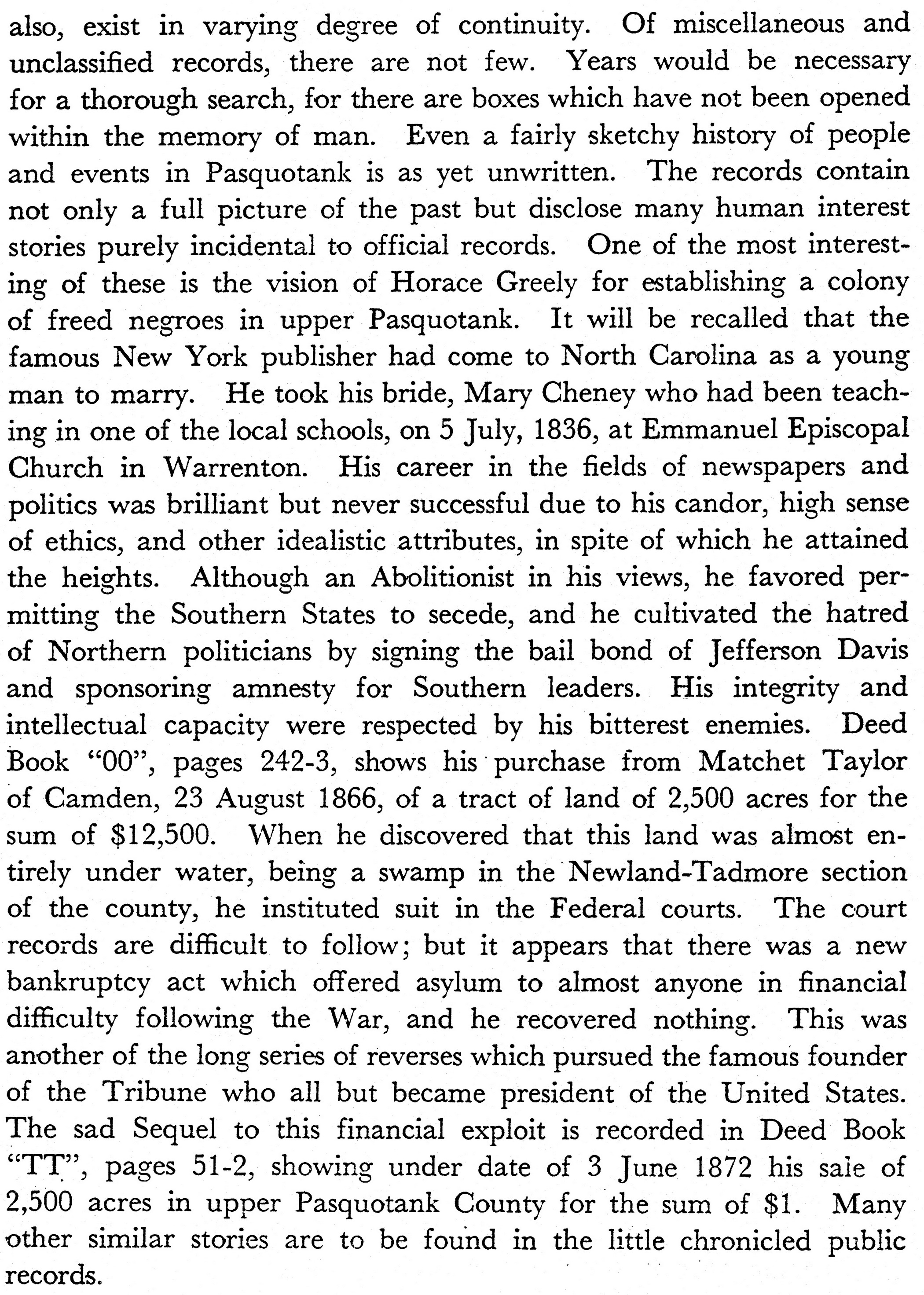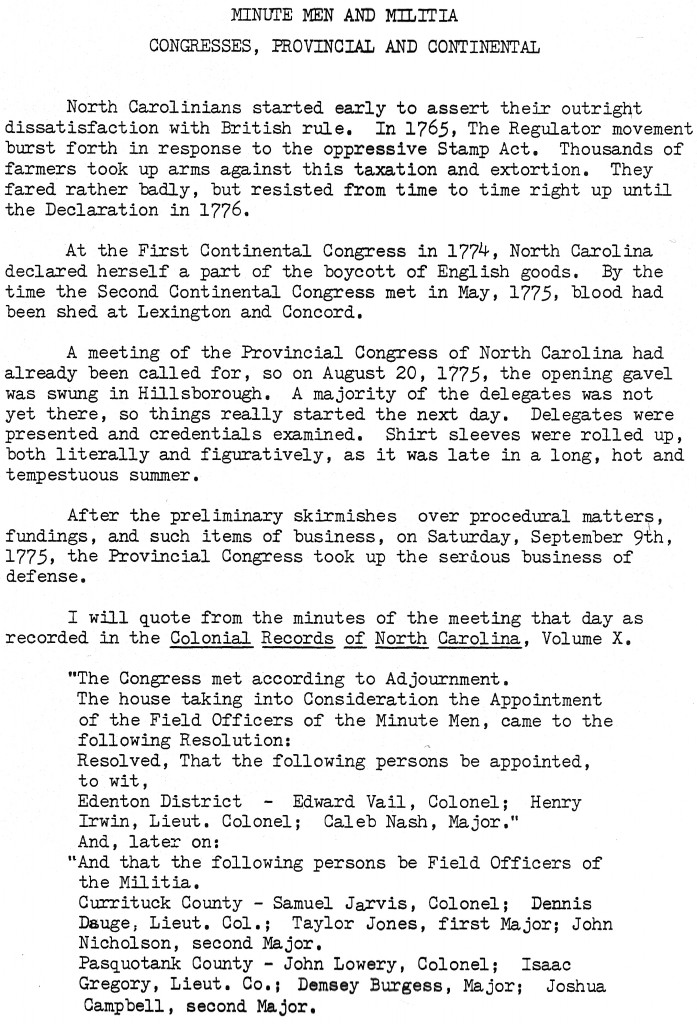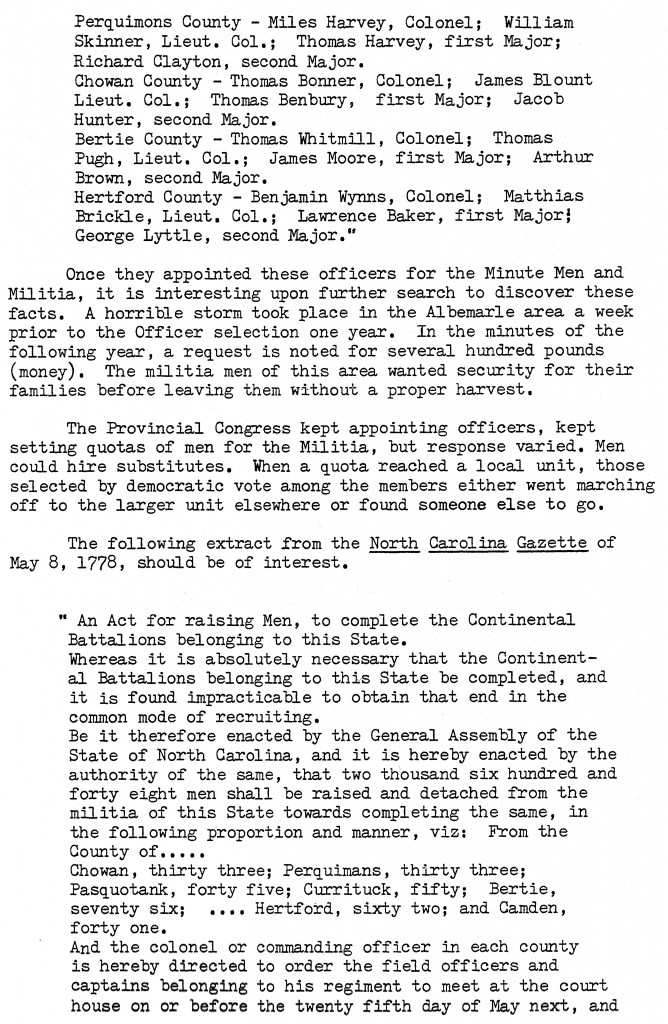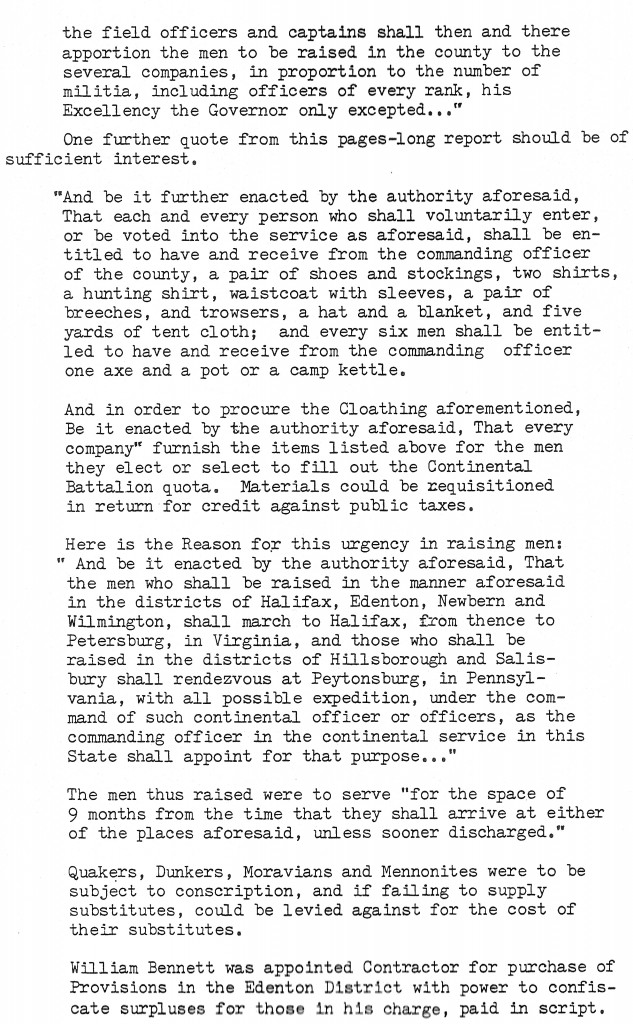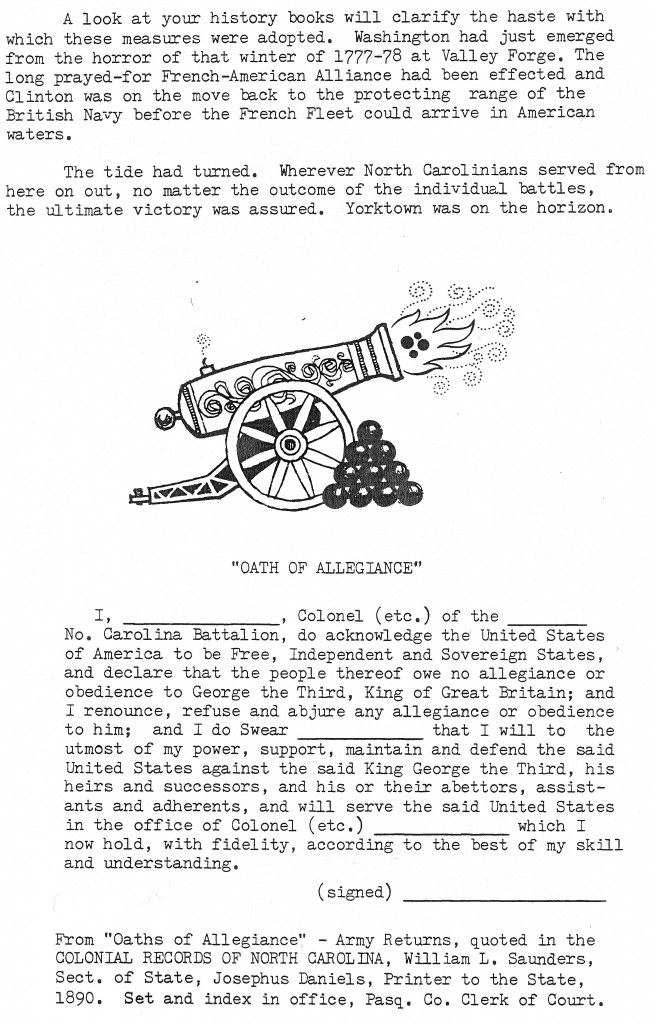QUAKER COMMUNITIES IN ALBEMARLE
From The Hill Family of Chowan County North Carolina
By Anne L. McCarthy
The land configurations of Albemarle made the area attractive and accessible. Laced with small streams, creeks, and deep rivers, the easy access by water into the untamed region offered ports for ocean-going ships able to take the settlers’ products directly to Caribbean ports and to the other colonies. Abundance of water also aided the farmers with their crops and for their homes. The Chowan, Perquimans, Pasquotank, and Little Rivers were linked with the smaller streams making a veritable water highway throughout the area. The source of these rivers was the Great Dismal Swamp, where the color of the water was a deep red, caused by the waters passing through the roots of the cypress trees. The water, however, was perfectly clear, tasted by no means unpleasant, and was quite wholesome. It had a diuretic effect on those who drank it, and prevented agues and fevers, or so it was claimed. Filled with the perils of virgin forests, native Indians, wild animals, insects, snakes, and reptiles, this area south of the Great Dismal Swamp was also more isolated from the English authorities.
Following the first landowners who settled along the main rivers and shores of Albemarle Sound, new arrivals were finding homesites father up near the heads of the four main rivers. When the word spread that this was a place where people were able to worship in freedom and that the Virginia government had less influence in the region, the Quakers in southern Virginia came to Albemarle in increasing numbers. They were an industrious, plain, sober, and hardy people who had already endured much hardship and privation. They were soon joined by other Quakers from the New England colonies who had heard that new Quaker settlements were being started in the south. One of these couples who came in the 1660’s was Henry and Hannah (Baskel) Phelps from Salem, Massachusetts. Among those who came from the Charlestown settlement in southern Carolina were Patrick Henley, John Culpeper, and Edward Mayo who had come originally from Barbados in the Caribbean.
On February 6, 1665, the first group of six freeholders met beneath a giant oak tree on the banks of Hall’s (Hill’s ?) Creek in Pasquotank Precinct1 to organize community affairs. William Drummond, one of those present at that meeting, had been appointed the first Governor of Albemarle in 1664 by Gov. Berkeley, acting on orders of the Lord Proprietors. George Catchmaid of Perquimans was chosen Assembly Speaker.2 Samuel Pricklove and George Durant were probably also among the original six at the meeting. Both served as local officials and were the first two settlers of the area. The isolation of Albemarle and the independent nature of it’s people were factors contributing to unstable government in the young colony in its first years of existence.
In 1676 Drummond returned to Virginia where he became actively involved in Bacon’s Rebellion. He was an ardent supporter of Nathaniel Bacon and thereby angered Governor Berkeley. When the rebellion was put down after Bacon’s death from illness, the Governor made Drummond the first of the rebels to pay the price for their disloyalty to his authority. Drummond was sentenced to be hanged. Mrs. Drummond and the children were put out of their home and were left wandering in the swamps near starvation.
The Lord Proprietors next named Samuel Stephens as Governor of Albemarle. He served from 1667-1669. Stephens was born in Jamestown in 1629 and was the first governor of any colony to be born in America. He was married to Frances Culpeper, the sister of Lord John Culpeper. When Stephens died in1669, she married Governor William Berkeley. After Berkeley’s death in 1677, she married thirdly Phillip Ludwell, Governor of Charlestown, in ‘south’ Carolina. Stephens had owned a tract of 4,000 acres of land in Albemarle which was sold upon his death to John Hill of York County. In 1693 this same tract of land was sold by John Hill’s son, Samuel Hill of Warwick Co. and his wife, Mary, to Governor Seth Sothel (Southwell).
Bacon’s Rebellion in Virginia had reverberations in Albemarle. Some of Albemarle’s residents had been active in the Virginia revolt, and they returned to Albemarle to continue stirring up discontent there. John Culpeper, who had come to Pasquotank in 1675 from the Charlestown settlement where he had been accused of inciting the people against their government, was one of these. He left Pasquotank in 1676 to become Nathaniel Bacon’s lieutenant during the rebellion in Virginia. When the revolt was put down, he escaped to Albemarle, where he continued to sow seeds of discontent.
Disagreement between the early settlers who bought their lands from the Indians and those who had received land patents from the Lord Proprietors was an underlying cause of dispute. In addition, conflict between Quakers and non-Quakers, while government attempts to restrict export of tobacco (the money crop) also resulted in discontent. Nine Friends were fined and imprisoned in 1680 for refusing to bear arms. Samuel Hill of Warwick was one of these men.
When unrest in Albemarle broke out in Culpeper’s Rebellion, in 1677, Thomas Miller, an apothecary from Pasquotank, was serving as Deputy Governor in place of Thomas Eastchurch. The rebels, led by John Culpeper, arrested Gov. Miller and Customs Collector, Timothy Biggs, and took over the government. In Pasquotank County, Culpeper is proudly claimed as America’s first governor of a free people in this country and Albemarle as the first independent colony in the new world. Culpeper’s widow, Sarah Mayo, daughter of Edward Mayo, again married in 1693 to Patrick Henley, the earliest Henley ancestor of the family that later became closely associated with the Hills.
Bacon’s and Culpeper’s Rebellions came perilously close to the members of the Hill family. As Quakers they did not take active roles in the insurrection, but they were closely associated with the officials who did.
For the first thirty years Albemarle was governed by independent men, and Quakers served in all levels of political office. While there was a steady conflict for governmental control in Albemarle between members of the established church and the Quaker faction, the Quakers dominated in early Pasquotank. John Archdale followed Culpeper as Governor from 1694-1696. He was a Quaker and a Lord Proprietor, having purchased John Berkeley’s share. When a law was passed requiring officeholders to take an oath to serve the English crown, the Quakers, who believed oaths should be made only to God, met opposition and were prohibited from holding public office. From that time on their influence waned.
In this new setting life was a constant challenge for survival. Families were more isolated and vied with the Indians for sustenance off the land. Living on lands bought from the Indians meant they were living among the natives. Early on the Quakers learned how to treat the Indians with respect and to coexist with them. In the process their children acquired the Indian skills of living with nature. In the next generation these were skills that enabled the young men to lead their people into newer untouched lands to the west.
In Albemarle life spans were short. With little medical resources other than the remedies handed down from generation to generation and surrounded by accidental risks, fevers, poisonous snakes and wild animals, men and women often were suddenly widowed and left with small children to care for without a home-maker or protector-provider. The widowed remarried quickly and often, some having three or four wives or husbands in their lifetimes. New marriage partners often came from within the small circle of neighboring families. These families came to be linked by intermarriage many times over. Marriage occurred at a young age for girls in particular. They learned the skills of home-making as a necessity to assist their mothers. Providing food, clothing, and health care for a family in the wilderness was no easy task and required the help of every hand at an early age. Without a pair of hardworking parents, a family could not survive. Families were large and children learned early to contribute to the work.
SAMUEL PRICKLOVE: AGITATOR
Samuel Pricklove was one of the first residents of Perquimans Precinct, arriving even before settler George Durant, in 1662. Pricklove was the first known purchaser of Indian lands in Albemarle and held a grant from Governor Berkeley of Virginia for a large tract on the Perquimans River near Durant, where the two men became life-long friends. Pricklove had moved from Nansemond County in Virginia with his wife, Rachel Lawrence, whose brother, Thomas Lawrence, was one of Nathaniel Bacon’s supporters in Bacon’s Rebellion. Pricklove held the offices of Registrar of deeds and Clerk of the Inferior Court under the administrations of two early Quaker Governors of Carolina in the 1650’s: Governor William Drummond (executed by Governor Berkeley in Bacon’s Rebellion) and Governor Archdale. Both Pricklove and Durant took part in the Culpepper Rebellion of 1677 and assisted in “leading the rabble” to depose the Deputy Governor Thomas Miller. For this crime of activism, Pricklove was sentenced to have his right ear amputated and be banished from the colony. The sentence was never carried out because Miller was deposed. Samuel Pricklove died in Perquimans County in 1692. He and his wife left two sons, Samuel and John. John Pritloe and his wife, Elizabeth, had six daughters, all of whom married men of substance and influence in Albemarle:
• Priscilla married John Sanders
• Judeth married Abram Sanders, son of John Sanders of Virginia
• Rachel married Robert Wilson, son of a Virginia Burgess
• Elizabeth married William Elliott
• Rebecca married Zacariah Chancy
• Leah married Joseph Smith. Leah and Joseph Smith were the grandparents of Mary Smith, wife of William Hill. John Smith, brother of Mary Hill, was one of the founders of Richmond, Indiana. Basil Sanders, who left 860 acres of land in Chowan County to a William Hill of Antigua in 1721, was likely the son of one of the above Sanders couples.
The early Quaker communities were models of life based on their Christian beliefs. The Quaker believed that God speaks directly to the human heart, and that no ministers or priests are needed to receive the blessings of God, which are available to every man and woman. They believed in the equality of men and women. They used no hymns or outward manifestations in their worship, keeping silent until a person felt moved by God to share a message. The Quakers tithed. They refused to take an oath of any kind, as they owed their allegiance only to God. They believed in simplicity which strips away the accretions of the centuries and used the term Thee because Jesus used Thee to His Friends. The appellation, Quaker, came from their enemies who accused them of Quaking in the presence of God, which they did.
The Quaker dissenters in England had been prohibited from attending the public schools there, leading the Friends to establish their own schools to provide their young people with the education and religious precepts of their faith. A high priority was placed on having the best teachers and schools possible in order to preserve their sect.
The Quaker Meeting House had two sides separated by partitions which could be removed for general meetings. The men had their meetings on one side and conducted their affairs with their own appointed committees. The women, treated as equals, had their own meetings and committees to deal with their own particular concerns. Each group assigned overseers to monitor the conduct of their members, arrange for disputes between members to be settled in a peaceful and fair manner, and to “look into and approve or disapprove” of the appropriateness of the intention of members to marry. The poor and orphaned children were provided for by funds set aside in each meeting from tithes for that purpose, and new homes were arranged for the orphans where they would be clothed, fed, and taught a trade.
In the frontier communities the safety and welfare of the people depended on the cooperation of all and a commitment to the good of the community. Because they lived in primitive circumstances and close proximity to the Indians from whom they had bought their land, the Quakers took care to treat the Indians fairly and to learn their ways of survival off the land. They set up schools for the native children to help them come to understand the ways of the white man. The earliest religious meetings in Albemarle were held in the homes of their leaders.
While the Quaker communities continued to grow in North Carolina and in Isle of Wight Co., Virginia, there remained a lingering unease over the tight control of the mother country affecting both the settler’s religious and economic lives. Young men were being conscripted into the militia to fight Indians on the western borders of Virginia and North Carolina and brought home with them news of the beautiful, undeveloped lands in the western parts of those states. The Quakers were assessing their local problems and the possibility of starting new settlements in the west.
The early Quaker communities were models of life based on their Christian beliefs. The Quaker believed that God speaks directly to the human heart, and that no ministers or priests are needed to receive the blessings of God, which are available to every man and woman. They believed in the equality of men and women. They used no hymns or outward manifestations in their worship, keeping silent until a person felt moved by God to share a message. The Quakers tithed. They refused to take an oath of any kind, as they owed their allegiance only to God. They believed in simplicity which strips away the accretions of the centuries and used the term Thee because Jesus used Thee to His Friends. The appellation, Quaker, came from their enemies who accused them of Quaking in the presence of God, which they did.
The Quaker dissenters in England had been prohibited from attending the public schools there, leading the Friends to establish their own schools to provide their young people with the education and religious precepts of their faith. A high priority was placed on having the best teachers and schools possible in order to preserve their sect.
The Quaker Meeting House had two sides separated by partitions which could be removed for general meetings. The men had their meetings on one side and conducted their affairs with their own appointed committees. The women, treated as equals, had their own meetings and committees to deal with their own particular concerns. Each group assigned overseers to monitor the conduct of their members, arrange for disputes between members to be settled in a peaceful and fair manner, and to “look into and approve or disapprove” of the appropriateness of the intention of members to marry. The poor and orphaned children were provided for by funds set aside in each meeting from tithes for that purpose, and new homes were arranged for the orphans where they would be clothed, fed, and taught a trade.
In the frontier communities the safety and welfare of the people depended on the cooperation of all and a commitment to the good of the community. Because they lived in primitive circumstances and close proximity to the Indians from whom they had bought their land, the Quakers took care to treat the Indians fairly and to learn their ways of survival off the land. They set up schools for the native children to help them come to understand the ways of the white man. The earliest religious meetings in Albemarle were held in the homes of their leaders.
While the Quaker communities continued to grow in North Carolina and in Isle of Wight Co., Virginia, there remained a lingering unease over the tight control of the mother country affecting both the settler’s religious and economic lives. Young men were being conscripted into the militia to fight Indians on the western borders of Virginia and North Carolina and brought home with them news of the beautiful, undeveloped lands in the western parts of those states. The Quakers were assessing their local problems and the possibility of starting new settlements in the west.
Concerned with the question of slavery, they knew they could not operate their farms without slave help. They preferred living in frontier areas where they were free of the social pressures of concentrated population. Albemarle was becoming quite populated.
HENRY WHITE
One of the earliest Quakers in Pasquotank County was Henry White who had come from Isle of Wight County, Virginia, around 1670. He had purchased lands at the head of Little River where a preparatory meeting had been established as early as 1663. White served as Registrar for Little River Meeting and for the Pasquotank Monthly Meeting which included four other meetings besides Little River. He served on the North Carolina Higher court and for short periods of time on the Precinct County Court.
White gave land for the building of a school alongside the meeting house which was the first school built in North Carolina, and he taught in that school. A poem White wrote in 1698 as a teaching tool for his students came to light at Guilford College in Greensboro, NC. This long poem is said to be the oldest extant work of poetry from the southern states. It apparently was used as a form of communication with other Quaker meetings in various regions and to instruct his pupils with a religious message of the Quaker faith at the same time.
As a young man White had attended school in Isle of Wight County, where his father made a living as a cooper and served as Justice of the Peace. His grandfather, Henry White, had lived on Queen’s Creek in York County, north of Williamsburg.
In 1631 Governor John Harvey determined to secure the area between the James and York Rivers by building a palisade across the peninsula between Archer’s Hope (College Creek) and Queen’s Creek. Incentives were offered to any settler who would relocate to that area to defend and protect the development of the area. Fifty acres were offered to each man who would relocate there for the first year, twenty-five acres for a second year. This may have been the incentive for families like the Whites and the Hills to spend a short period at Queen’s Creek in York county, later returning to the counties south of the James River.
